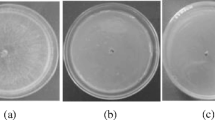Abstract
Bacillus sp. strain MA04 a plant growth-promoting rhizobacteria (PGPR) showed hemolytic activity on blood agar plates, and the supernatant from liquid culture in nutrient broth at 24 h exhibited emulsification activity, suggesting the production of biosurfactants. In antagonist assays, the supernatant showed antifungal activity against phytopathogenic fungi such as Penicillium expansum, Fusarium stilboides, Sclerotium rolfsii y Rhizoctonia solani, finding a reduction of mycelial growth of all fungi tested, ranging from 35 to 69%, this activity was increased with time of culture, accomplishing percentages of inhibition up to 85% with supernatants obtained at 72 h. Then, the crude biorsurfactant (CB) was isolated from the supernatant in order to assay its antagonistic effect on the phytopathogens previously tested, finding an increase in the inhibition up to 97% at 500 mg/L of CB. The composition of CB was determined by infrared spectroscopy, identifying various functional groups related to lipopeptides, which were purified by high-performance liquid chromatography and analyzed by MALDI-TOF/TOF–MS, revealing a mixture of fengycins A and B whose high antifungal activity is been widely recognized. These results show that PGPR Bacillus sp. MA04 could also contribute to plant health status through the production of metabolites with antimicrobial activity.

Similar content being viewed by others
References
De-Souza R, Ambrosini A, Passaglia MP (2015) Plant growth-promoting bacteria as inoculants in agricultural soils. Genet Mol Biol 38:401–419. https://doi.org/10.1590/S1415-475738420150053
Duan G, Christian N, Schwachtje J, Walther D (2013) The metabolic interplay between plants and phytopathogens. Metabolites 3:1–23. https://doi.org/10.3390/metabo3010001
Sharp RG (2013) A review of the applications of chitin and its derivatives in agriculture to modify plant-microbial interactions and improve crop yields. Agronomy 3:757–793. https://doi.org/10.3390/agronomy3040757
Ongena M, Jacques P (2008) Bacillus lipopeptides: versatile weapons for plant disease biocontrol. Trends Microbiol 16:115–125. https://doi.org/10.1016/j.tim.2007.12.009
Cao Y, Xu Z, Ling N, Yuan Y (2012) Isolation and identification of lipopeptides produced by B. subtilis SQR 9 for suppressing Fusarium wilt of cucumber. Sci Hort 135:32–39. https://doi.org/10.1016/j.scienta.2011.12.002
Luna ML, Martínez PRA, Hernández IM, Arvizu MSM (2013) Characterization of rhizobacteria isolated from tomato and their effect on tomato and bell pepper growth. Rev Fit Mex 36:63–69
Velázquez RR, Contreras CHA, Macías RL, Hernández MA (2011) Role of the 4-phosphopantetheinyl transferase of Trichoderma virens in secondary metabolism and induction of plant defense responses. Mol Plant Microbe Interact 24:1459–1471. https://doi.org/10.1094/MPMI-02-11-0045
Sánchez VSE, Martínez PRA, Castillo TJ, Fernández EE (2008) Antagonismo de levaduras nativas contra la pudrición azul (Penicillium expansum Link) en frutos de manzana. Rev Fitotec Mex 31:359–366
Sandoval CRA, Martínez PRA, Hernández IM, Fernández EE (2011) Control biológico y químico contra Fusarium stilboides en pimiento morrón (Capsicum annuum L.) en poscosecha. Rev Chapingo Ser Hortic 17:161–172
Issazadeh K, Kazemi RS, Zarrabi S, Reza RM (2012) Antagonism of Bacillus species against Xhantomonas campestris pv. Campestris and Pectobacterium carotovorum subsp. Carotovorum. Afr J Microbiol Res 6:1615–1620. https://doi.org/10.5897/AJMR12.075
Zhu Z, Zhang J, Wu Y, Ran W (2013) Comparative study on the properties of lipopeptide products and expression of biosynthetic genes from Bacillus amyloliquefaciens XZ-173 in liquid fermentation and solid-state fermentation and solid-state fermentation. World J Microbiol Biotechnol 29:2105–2114. https://doi.org/10.1007/s11274-013-1375-4
Kishore GK, Pande S, Podile AR (2005) Biological control of collar rot disease with broad-spectrum antifungal bacteria associated with groundnut. Can J Microbiol 51:123–132. https://doi.org/10.1139/w04-119
Fisher AA, Labenski MT, Monks TJ, Lau SS (2011) Utilization of MALDI-TOF to determine chemical protein adduct formation in vitro. In: Jean CG (ed) Drug safety evaluation. Humana Press, India, pp 303–315. https://doi.org/10.1007/978-1-60761-849-2_18
Cooper DG, Goldeberg BG (1987) Surface-active agents from two Bacillus species. Appl Envion Microbiol 53:224–229
Rattes ACC, Marques AV, Montezano MJ, De Azevedo DJ (2015) Exploiting the aerobic endospore-forming bacterial diversity in saline and hypersaline environments for biosurfactant production. BMC Microbiol 15:1–17. https://doi.org/10.1186/s12866-015-0575-5
Velho RV, Medina FC, Segalin J, Brandelli A (2011) Production of lipopeptides among Bacillus strains showing growth inhibition of phytopathogenic fungi. Folia Microbiol 56:297–303. https://doi.org/10.1007/s12223-011-0056-7
El-Sheshtawy HS, Aiad I, Osman ME, Abo-Elnasr AA (2015) Production of biosurfactant from Bacillus licheniformis for microbial enhance oil recovery and inhibition the growth of sulfate reducing bacteria. Egypt J Petrol 24:155–162. https://doi.org/10.1016/j.ejpe.2015.05.005
Walter V, Syldartk C, Hausmann R (2010) Screening concepts for the isolation of biosurfactant producing microorganisms. In: Sen R (ed) Biosurfactants. Springer, New York, pp 1–13. https://doi.org/10.1007/978-1-4419-5979-9
Gudiña EJ, Fernandes EC, Rodrigues AI, Teixeira JA (2015) Biosurfactant production by Bacillus subtilis using corn steep liquor as culture medium. Front Microbiol 6:1–7. https://doi.org/10.3389/fmicb.2015.00059
Varadavenkatesan T, Murty VR (2013) Production of a lipopeptide biosurfactant by a novel Bacillus sp. and its applicability to enhanced oil recovery. ISRN Microbiol 2013:1–8. https://doi.org/10.1155/2013/621519
Chen H, Wang L, Su CX, Gong GH (2008) Isolation and characterization of lipopeptide antibiotics produced by Bacillus subtilis. Lett Appl Microbiol 47:180–186. https://doi.org/10.1111/j.1472-765X.2008.02412.x
Yang H, Li X, Li X, Yu H (2015) Identification of lipopeptide isoforms by MALDI-TOF-MS/MS based on the simultaneous purification of iturin, fengycin, and surfactin by RP-HPLC. Anal Bioanal Chem 407:2529–2542. https://doi.org/10.1007/s00216-015-8486-8
Pathak KV, Keharia H (2014) Application of extracellular lipopeptide biosurfactant produced by endophytic Bacillus subtilis K1 isolated from aerial roots of banyan (Ficus benghalensis) in microbially enhanced oil recovery (MEOR). 3. Biotech 4:41–48. https://doi.org/10.1007/s13205-013-0119-3
Bin HL, Qi SZ, Zhang T, Min YZ (2007) Fengycin antibiotics isolated from B-FS01 culture inhibit the growth of Fusarium moniliforme Sheldon ATCC 38932. FEMS Microbiol Lett 272:91–98. https://doi.org/10.1111/j.1574-6968.2007.00743.x
Sachdev DP, Cameotra SS (2013) Biosurfactants in agriculture. Appl Microbiol Biotechnol 97:1005–1016. https://doi.org/10.1007/s00253-012-4641-8
Kumar SA, Singh CS (2013) Efficiency of lipopeptide biosurfactants in removal of petroleum hydrocarbons and heavy metals from contaminated soil. Environ Sci Pollut Res 20:7367. https://doi.org/10.1007/s11356-013-1752-4
Acknowledgements
The authors gratefully acknowledge financial support provided by “Fondo de Vinculación—Universidad Autónoma de Querétaro”, and we wish to thank both Dra. Alicia Chagolla López and Dra. Yolanda Rodríguez Aza for their invaluable support in the chromatographic and MALDITOF/TOF analysis.
Author information
Authors and Affiliations
Corresponding author
Rights and permissions
About this article
Cite this article
Hernández-Morales, A., Martínez-Peniche, RA., Arvizu-Gómez, Jl. et al. Production of a Mixture of Fengycins with Surfactant and Antifungal Activities by Bacillus sp. MA04, a Versatile PGPR. Indian J Microbiol 58, 208–213 (2018). https://doi.org/10.1007/s12088-018-0711-7
Received:
Accepted:
Published:
Issue Date:
DOI: https://doi.org/10.1007/s12088-018-0711-7




